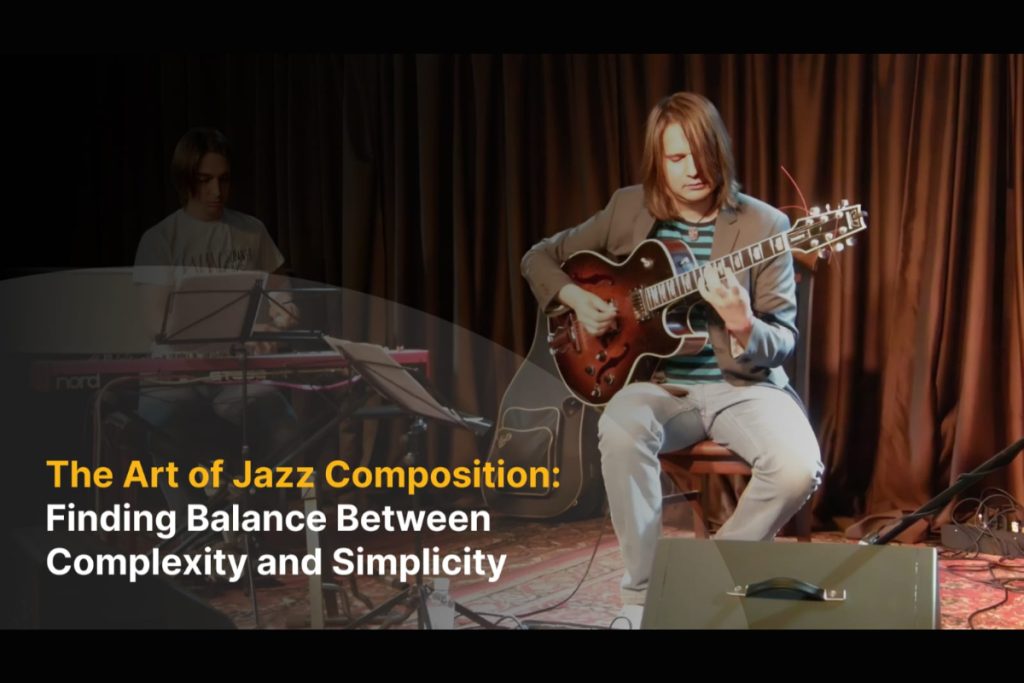
Photo Credit: The Art of Jazz Composition
Jazz composition is a delicate interplay between technical sophistication and emotional accessibility. While jazz thrives on harmonic depth and rhythmic freedom, the most compelling compositions combine complex structures with memorable, compelling themes that connect with listeners.
Digital Music News is proud to partner with outside agencies to create opportunities for artists to be visible to the music industry.
Ievgen Pugachov is an award-winning jazz guitarist, whose history is lengthy and notable. Here, he discusses how jazz composers manage this balance by incorporating unconventional harmonies and advanced techniques while maintaining coherence and expressiveness in their music.
Jazz composition rests on three core elements: melody, harmony, and rhythm. While jazz encourages freedom, these elements provide the structure and cohesion that give a piece its shape. A strong melody makes it memorable, harmony adds depth, and rhythm drives its energy.
Traditional jazz forms balance stability and creativity:
– The 12-bar blues remains a foundational structure.
– The AABA form offers contrast through repetition and variation.
– Modal jazz, led by artists like Miles Davis, opened new paths for harmony and improvisation.
Composers like Duke Ellington, Thelonious Monk, and Charles Mingus redefined these forms – through rich orchestration, bold harmonic choices, and genre fusion – showing how jazz structures can evolve while preserving their core identity.
Ievgen Pugachov has also come a long way in combining traditional jazz frameworks with modern harmonic shifts, unexpected modulations, and contemporary rhythmic patterns. As he claims, improvisation and one’s own unique sound appear only after accumulated experience. Listening to such jazz greats as Pat Metheny, Kurt Rosenwinkel and Wayne Shorter, he was able to combine different motives and techniques, thereby developing jazz composition.
Embracing Complexity: Expanding Harmonic and Rhythmic Language
Jazz composition thrives on harmonic and rhythmic experimentation, helping composers create unpredictable and expressive soundscapes. As Ievgen Pugachov notes, stepping beyond traditional forms brings depth and freedom to the music.
A key technique is non-functional harmony, where chords move in unexpected ways. Combined with quartal voicings, chromaticism, and extended harmonies (9ths, 11ths, 13ths), this approach expands the tonal palette. Pat Metheny influenced Ievgen’s use of such methods, which often appear in his work. He has taken it to the next level though and made such sounds his own.
Rhythmically, composers explore odd meters (5/4, 7/8, 11/8) and polyrhythms to add motion and surprise. These tools give modern jazz a progressive, evolving feel.
It is important how different jazz schools approach the expansion of harmony. Performing throughout Poland and Germany, Ievgen noticed how European jazz music gravitates toward avant-garde, original performance and unusual sound. In America, tradition comes to the fore – there, they study the basics of jazz in more depth and implement them in their own playing. This is what distinguishes both the style and the complexity of the performance. By combining both approaches in his performance, Ievgen Pugachov came to the creation of new and avant-garde harmonic textures, while maintaining a strong melodic identity. Thus, even the most complex works remain fascinating and emotionally captivating.
The Power of Simplicity: Crafting Memorable Themes
In a jazz composition, complexity can add depth, but it is the simplicity that makes the music truly resonate. A strong, memorable theme serves as the foundation of any great composition, providing an emotional connection for listeners while allowing room for harmonic and rhythmic exploration.
Ievgen Pugachov’s compositional style is defined by his ability to create melodies that are both accessible and complex. His themes appeal to both casual listeners and trained musicians, finding a balance between singability and harmonic richness. Rather than overloading a piece with complexity, he focuses on melodic clarity, ensuring that each phrase has a distinct identity.
As Ievgen notes, there are several effective techniques that can be used to write a jazz melody:
– Singable, yet harmonically rich lines: strong melodies should be easy to hear, but also allow for harmonic depth and variation.
– Use of space and phrasing: leaving space between notes gives the melody more impact, allowing it to be expressive and natural.
– Repetition and variation: repeating motifs create a sense of familiarity, while subtle variations keep the listener’s attention.
Blending the Two: Finding Balance in Jazz Composition
The most compelling jazz compositions balance complexity and accessibility, ensuring that complex ideas remain engaging rather than overwhelming. By blending rich harmonic and rhythmic layers with clear, memorable themes, composers create music that is both intellectually and emotionally satisfying.
One effective approach is to anchor the piece in a strong melody, adding depth through extended harmonies, modal interchange, and reharmonization. These techniques introduce color and variation without losing cohesion.
Note that earlier jazz was characterized by simpler harmonies but more complex melodies. This is typical of bebop and the work of Charlie Parker, early Miles Davis, Thelonious Monk. Later, Wayne Shorter began using pentatonic motifs with complex non-functional harmony, which made his melodies easily recognizable and acquired a special sound. Even though this approach originated in the 1960s, it is still considered modern jazz because Shorter set a new trend.
Ievgen Pugachov, having deeply studied Shorter’s music and style, also became a great apologist for this approach, that melodies should be simpler, more logical, more recognizable, but at the same time the harmony can be complex to create an interesting and unusual sound.
Ievgen also believes in striving for balance. His lead performances with such Grammy Award-winning artists as John Beasley, Paul Francis, Dan Pugach, Dave Smith, Frank Parker and others clearly illustrate how structured compositions can still leave room for improvisation, making each performance both sophisticated and spontaneous. His music combines harmonic sophistication and melodic power, resonating with both musicians and audiences.
Modern Jazz Composition: Adapting to Contemporary Influences
Jazz continues to evolve under the influence of technology, cross-genre experimentation, and new listening habits. Contemporary composers are combining electronic elements, traditional and world music influences, and digital production tools, expanding the genre’s sound while maintaining its improvisational core.
Electronic elements like synthesizers, loop pedals, and digital effects have transformed jazz, adding depth and atmosphere. Sampling and layering allow musicians to create textures beyond traditional acoustic settings. At the same time, jazz continues to blend with rock, funk, and traditional music to create fresh, dynamic compositions that appeal to a wider audience.
Streaming platforms have also shaped modern jazz, encouraging shorter, more structured compositions that fit modern listening habits while maintaining artistic integrity.
As time moves on, musicians shouldn’t stand still either. In 2021, Ievgen launched the House Sessions project on YouTube. This project has become a platform for musicians who bring their original compositions and experiment with different styles and sounds. For example, a piece may be written for a saxophone, but here it will be played on a trumpet. The participants of House Sessions try something new and unusual to look at their works from a different angle and rethink them. In a way, this approach becomes the driving force of the genre, opening up new facets.
Jazz composition today is a constantly evolving craft – a dialogue between tradition and innovation. The most powerful works are those that find a balance: between complex harmonic ideas and melodic clarity, between freedom and form, between intellect and emotion.
Throughout this article, we’ve seen how Ievgen Pugachov embodies that balance. Rooted in the American jazz tradition and shaped by diverse influences from Europe and the U.S., his approach to composition blends avant-garde harmony, rhythmic experimentation, and strong thematic identity. Whether drawing inspiration from legends like Pat Metheny and Kurt Rosenwinkel, or creating accessible, memorable melodies for broad audiences, Ievgen demonstrates that great jazz builds on its roots.
As jazz continues to intersect with technology, global genres, and new modes of consumption, the challenge for modern composers remains the same: to innovate without losing the soul of the music. Pugachov’s work – especially through his House Sessions project – shows how this can be done, offering a blueprint for the next generation of jazz composers.
Ultimately, the art of jazz composition lies in balance: complexity that invites exploration, simplicity that touches the heart, and improvisation that makes each performance truly alive.

